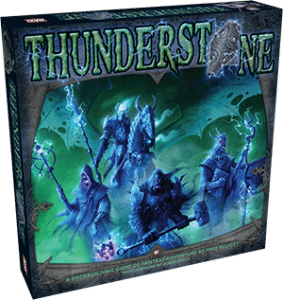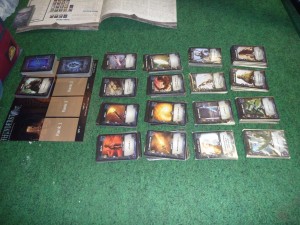Review: Thunderstone from Alderac Entertainment Group
“Thunderstone

Another aspect of a deck-building games are options. I will explain this a bit more later, but there are many types of cards in the box, some of which are not used for every game. Players either decide which cards to use during the game or there is a random draw option, so neither player chooses their favorite cards. Unused cards stay out of play. This configuration change for every game keeps the game “fresh” and tends to stave off the “one good strategy” every player uses that kills many games.
Deck-building games (usually) are not collectible and have no random element. Supplements list their contents and what each card does. This pleases me because I despise the CCG business model
Which brings me to “Thunderstone
“Thunderstone’s” premise is that ages ago wizards sealed the “First Thunderstone” inside Grimhold Dungeon. Of course, endless evil minions infested the dungeon and the heroes must use all of their deck-building might to overcome them and recover the “Thunderstone.”
I ran my review game with only two players, but the game supports up to five players. Each player draws six cards and reveals them in turn. In the first round, you might have enough to fight a very small monster in the dungeon, but most likely you will buy something in the village. Some cards in your hand have a gold value on them, so you add up your gold for that round and see what you want and can afford in the village. The village is the four rows of cards below the “Dungeon Hall” board.
The village is essentially a big shopping mall for adventurers. Each turn players choose to either go to the village and purchase equipment and heroes for their deck or use experience points for hero upgrades. So, as a first turn you buy the “barkeep” and add him to the discard pile. After a reshuffle and a fresh draw, the “barkeep” is available for the player. Strategy comes from knowing what and when to buy something and you have only the gold in your current hand.
Once you have an adventuring party worthy of killing something, you head to the “Dungeon Hall.” Defeating a monster is quite simple; use your cards to generate more damage than the creature has hit points. In this, “Thunderstone
Defeat a monster and add him to your deck. You also receive experience point cards, useable in the village for hero upgrades/leveling. Beware! Some creatures give you diseases or other ongoing effects that definitely impact your long-term strategy, so stay alert for special powers.
As the monsters fall to the heroes, the monster draw deck shrinks until the “Thunderstone” appears. Once the stone reaches the first field of the “Dungeon Hall,” the game ends. It is possible to claim the stone for some extra victory points, but it is not required to end the game. Players go through their decks, add up the victory points listed on the cards and high score wins.
I liked “Thunderstone
As much as I enjoyed “Thunderstone,” I do have some advice for players. Because of the many types of cards, organization is key to long-term enjoyment. Never just throw the cards back in the box without sorting them! It just adds setup time on later games and with supplements coming out (Thunderstone: Wrath of the Elements
Remember game mechanics require very frequent deck shuffles. Card protectors are, in my opinion, required.
Have fun storming the dungeon!
Trask, The Last Tyromancer
Full Disclosure: I received a review copy of this game from AEG.

This sounds like the game Dominion.